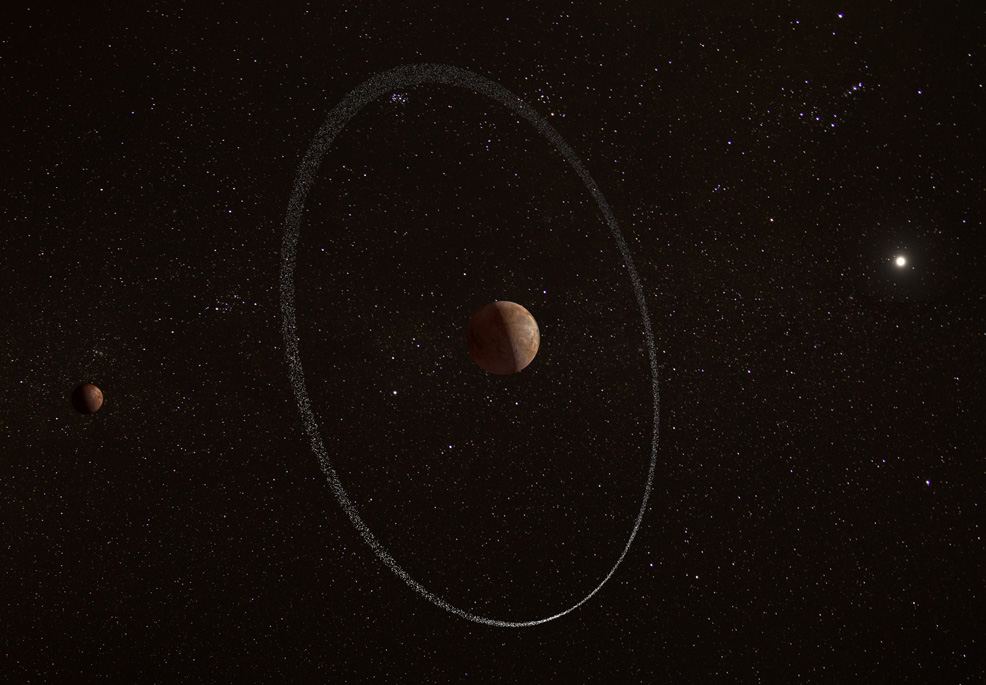
13th February 2023 New ring system found in our Solar System The minor planet Quaoar is now known to have a ring system, following observations by the CHEOPS space telescope.
Quaoar (pronounced "kwah-waar") is a dwarf planet in the Kuiper belt, a region of icy objects beyond Neptune, where it orbits at a distance of between 41 and 45 astronomical units (AU). Having only been discovered in 2002, it is still considered relatively new, with much to be learned about its history, appearance and physical characteristics. Thanks to recent ground-based observations, combined with ESA's space-based telescope CHEOPS, we now know that Quaoar has a ring. Notably, this is much further out from the planet than would be expected, calling into question current theories of how ring systems are formed. In addition to measurements from CHEOPS, astronomers used HiPERCAM – an extremely sensitive, high-speed camera – mounted on the 10.4 metre diameter Gran Telescopio Canarias (GTC) on La Palma, the world's largest optical telescope. The ring is too small and faint to see directly in an image. Instead, the researchers made their discovery by observing an occultation, which means the light from a background star is blocked by Quaoar as it orbits the Sun. This event lasted for less than a minute. However, two dips in light unexpectedly preceded and followed the occultation, indicative of a ring system around Quaoar. CHEOPS is normally used for studying exoplanets, but its capabilities can be applied to objects within our own Solar System as well. In this case, it proved to be decisive in corroborating the ground-based data from the GTC. "The CHEOPS observations have played a key role in establishing the presence of a ring around Quaoar, in an application of high precision, high cadence photometry that goes beyond the more typical exoplanet science of the mission," said Kate Isaak, ESA's Project Scientist. The gas giants – Saturn, Jupiter, Uranus, and Neptune – all have well-known ring systems. But only three of the many dwarf planets in our Solar System are confirmed to possess them: Quaoar, along with Chariklo and Haumea. What makes the ring system around Quaoar remarkable is that it has formed at a distance of 7.4 planetary radii – more than double the theoretical maximum of the so-called Roche limit. This is defined as the outer boundary of where ring systems can survive, beyond which their material tends to coalesce into moons. Saturn, for comparison, has its main rings within about three planetary radii. This discovery has therefore forced a rethink on theories of ring formation. Quaoar's ring has an irregular width, resembling Saturn's F ring. According to the researchers, this may imply the presence of small, kilometre-sized moonlets embedded within the ring and gravitationally perturbing its material. Quaoar's ring is likely composed of icy particles that elastically collide with each other but without accreting into a larger mass. A total of 59 academics collaborated on this study, led by the Federal University of Rio de Janeiro in Brazil, with contributions from six British universities – Sheffield, Edinburgh, St Andrews, Warwick, Birmingham, and the Open University. Their results are published this month in Nature. Excluding its newly confirmed ring, Quaoar has a diameter of 1,110 km (690 mi), about half that of Pluto. It has a single known satellite, called Weywot, seen on the left of the artist's impression above. Quaoar's orbital period is longer than Pluto's, at 289 years. Perihelion (its closest point to the Sun) will occur in 2075. Perhaps by then, a combination of telescopes and close-range spacecraft will have treated us to high-resolution views of this distant, mysterious world.
Comments »
If you enjoyed this article, please consider sharing it:
|







